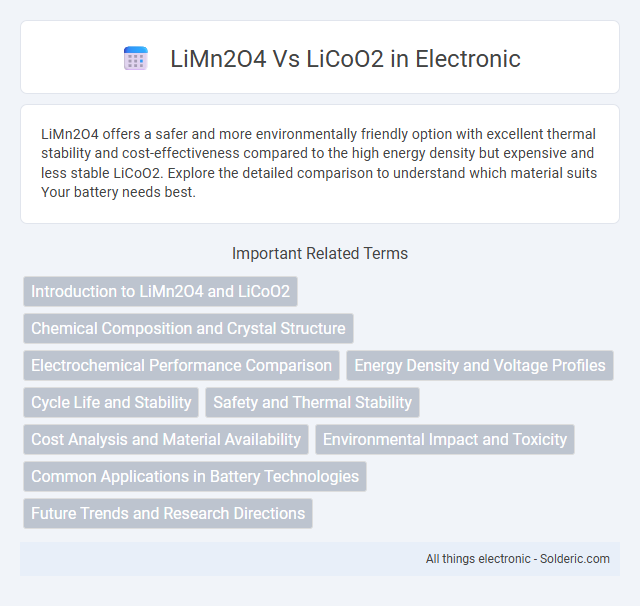LiMn2O4 offers a safer and more environmentally friendly option with excellent thermal stability and cost-effectiveness compared to the high energy density but expensive and less stable LiCoO2. Explore the detailed comparison to understand which material suits Your battery needs best.
Comparison Table
| Property | LiMn2O4 (Lithium Manganese Oxide) | LiCoO2 (Lithium Cobalt Oxide) |
|---|---|---|
| Chemical Formula | LiMn2O4 | LiCoO2 |
| Crystal Structure | Spinel | Layered |
| Voltage (Nominal) | 4.0 V | 3.7 V |
| Capacity (Theoretical) | 148 mAh/g | 274 mAh/g |
| Cycle Life | Good (500+ cycles) | Moderate (300-500 cycles) |
| Thermal Stability | High | Lower |
| Cost | Lower (Manganese is abundant) | Higher (Cobalt is scarce and expensive) |
| Environmental Impact | Lower toxicity | Higher toxicity and ethical concerns |
| Applications | Power tools, electric vehicles, grid storage | Smartphones, laptops, electric vehicles |
Introduction to LiMn2O4 and LiCoO2
LiMn2O4 and LiCoO2 are two widely used cathode materials in lithium-ion batteries, each exhibiting distinct electrochemical properties and crystal structures. LiMn2O4 offers a spinel structure with excellent thermal stability and safety advantages, while LiCoO2 features a layered structure known for its high energy density and long cycle life. Understanding the differences between LiMn2O4 and LiCoO2 helps optimize your battery choice based on performance requirements and applications.
Chemical Composition and Crystal Structure
LiMn2O4 consists of lithium manganese oxide with a spinel crystal structure, characterized by a three-dimensional framework that enables fast lithium-ion diffusion, enhancing rate capability and thermal stability. LiCoO2 is composed of lithium cobalt oxide with a layered rock-salt crystal structure, which allows for high voltage operation but shows limited lithium-ion mobility and lower thermal stability compared to spinel. The differing crystal architectures significantly influence their electrochemical performance, with LiMn2O4 favoring safety and cycle life, while LiCoO2 offers higher energy density.
Electrochemical Performance Comparison
LiMn2O4 exhibits a stable voltage plateau around 4.0 V with moderate capacity retention and excellent cycling stability due to its robust spinel structure, making it suitable for high-rate applications. LiCoO2 offers higher initial capacity, approximately 140-160 mAh/g, and a higher operating voltage near 4.2 V, but suffers from faster capacity fading and thermal instability during prolonged cycling. The electrochemical performance of LiMn2O4 prioritizes longevity and safety, whereas LiCoO2 favors higher specific energy but requires careful thermal management to maintain performance.
Energy Density and Voltage Profiles
LiMn2O4 cathodes deliver a moderate energy density around 100-120 Wh/kg, whereas LiCoO2 offers higher energy density typically reaching 150-200 Wh/kg, making it more suitable for applications requiring longer battery life. The voltage profile of LiMn2O4 features a stable plateau near 4.0 V, providing consistent discharge performance, while LiCoO2 exhibits a slightly higher nominal voltage around 3.7-4.2 V with smoother voltage decay during cycling. Your choice between these materials depends on prioritizing energy density or thermal stability and voltage consistency for specific battery applications.
Cycle Life and Stability
LiMn2O4 exhibits superior cycle life compared to LiCoO2, maintaining capacity retention over 1000 cycles due to its robust spinel structure. The enhanced thermal and structural stability of LiMn2O4 reduces degradation and prolongs battery lifespan, especially under high-rate conditions. In contrast, LiCoO2 experiences faster capacity fading and structural changes, limiting its long-term cycling stability despite higher initial energy density.
Safety and Thermal Stability
LiMn2O4 offers superior safety and thermal stability compared to LiCoO2 due to its robust spinel structure that reduces the risk of thermal runaway and overheating. LiCoO2 batteries are more prone to thermal decomposition at elevated temperatures, which can lead to fire hazards. Choosing LiMn2O4 for your application enhances safety by minimizing thermal instability during charge and discharge cycles.
Cost Analysis and Material Availability
LiMn2O4 offers a cost advantage over LiCoO2 due to lower raw material expenses and greater abundance of manganese compared to cobalt, making battery production more economically viable. Cobalt's limited supply and geopolitical concentration drive up LiCoO2 prices, causing supply chain volatility and potential sustainability concerns. For your energy storage needs, choosing LiMn2O4 can translate to reduced material costs and more stable availability without sacrificing essential battery performance.
Environmental Impact and Toxicity
LiMn2O4 batteries have a lower environmental impact compared to LiCoO2 due to the abundance and lower toxicity of manganese, reducing concerns related to mining and disposal. LiCoO2 contains cobalt, which is associated with significant ethical and environmental issues, including toxic mining processes and challenges in recycling. Choosing LiMn2O4 over LiCoO2 can contribute to a more sustainable and less hazardous energy storage solution for your applications.
Common Applications in Battery Technologies
LiMn2O4 is widely used in electric vehicle and power tool batteries due to its thermal stability, lower cost, and environmentally friendly manganese-based composition. LiCoO2 remains dominant in portable electronic devices such as smartphones and laptops for its high energy density and stable voltage output. Your choice between these materials depends on prioritizing cost-effectiveness and safety or maximizing energy capacity and runtime.
Future Trends and Research Directions
Research on LiMn2O4 focuses on improving cycle stability and mitigating capacity fading through doping and nanostructuring techniques, targeting cost-effective and environmentally friendly lithium-ion batteries. LiCoO2 remains widely used for its high energy density, but future trends emphasize enhancing thermal stability and cobalt reduction to address resource scarcity and ethical concerns. Your choice in battery materials will likely benefit from advancements in solid-state electrolytes and sustainable synthesis methods tailored to balance performance and environmental impact.
LiMn2O4 vs LiCoO2 Infographic

 solderic.com
solderic.com